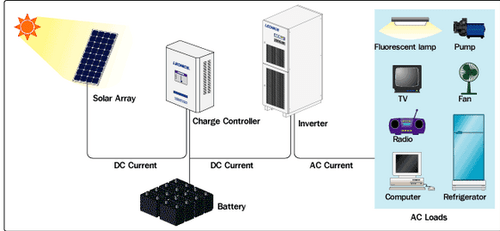Calculating the number of electric batteries for the solar system
Calculate the number of electric batteries for the solar system, After we got acquainted with the series of solar system design articles on the first steps of design and how to sort and calculate electrical loads.
We will now learn about the topic of how to calculate the number of electric batteries to provide the sufficient energy we need at night, We knew after making calculations that the energy consumed at night is 6811 watt-hours.
Thus, we will learn how to calculate the number of batteries based on the following requirements: The ratio of depth of discharge, efficiency (battery at temperature and cable efficiency), number of cloudy days, energy consumed and system voltage.
What are the conditions for building a solar system?
What are the conditions for building a solar system? An important question that comes to the mind of everyone who wants to prepare for the installation of a small or medium-sized solar system.
We present to you the first in a series of articles on designing an integrated solar photovoltaic system. It is an important topic on which the rest of the building steps of the solar system are built.
What are the conditions for building a solar system?
There are several conditions that we must know with high accuracy, namely:
- O no: Study the environment of the site on which the panels are to be installed, In the sense is the site an open place and not veiled from the sun? And can the roof of the building bear the weight of the platform and solar panels?
- Secondly: Determine the right type of solar system, Do you want a grid-connected, isolated, or hybrid system?
- Third: What is the required system capacity?
- Fourthly: Do I have enough space to install the number of panels? And do the front panels cause a shadow on the back panels or not?
Study the environment of the site on which the panels are to be installed
Make sure that the site is not surrounded by any obstacle that may cause shading on the solar panels, whether it is an adjacent building or trees, In addition, we need to know the extent to which the roof of the building can bear the weight that is placed on it.
Determine the right type of solar system
There are three systems available, one of which can be chosen:
 The system connected to the electricity network (on-grid system).
The system connected to the electricity network (on-grid system).- Off grid system (off grid system).
- Hybrid System.
Important note:
By off-grid system, we do not mean that it cannot be fed by a public electricity source, but rather it cannot sell the surplus power of the panels to the electricity company, Therefore, some may think that the word “isolated” or “off the grid” is that it cannot be fed by the electricity source of the public network.
We repeat that the off-grid system (the off-grid system) can be fed from the power grid source, But he couldn’t sell the panels’ energy to the public electricity grid like an on-grid system.
Required solar system capacity
The required capacity of the solar system is determined based on the total energy consumed by the electrical loads (night loads and daytime loads), so that a simplified table is made showing the name of the device, its capacity, the number of operating hours, and the total energy consumed for each load during the day and at night in case you want to operate it at night.
Roof area and number of solar panels
An important step that must be taken into consideration after estimating the number of solar panels needed. It has a perfection between the roof area of the building and the total area of the solar panels that must be installed so that the roof can accommodate the entire number of panels while leaving enough distance between the front panels and the back panels.
In general, generating 1 kilowatt-hour of energy through solar panels requires a surface area of approximately 10 square metres. This means that when planning to install solar panels with a capacity of 2 kWh, it will need approximately 20 square meters of space.
There are some other things to consider, such as: Initial costs of installing the system.
Sorting and calculating the electrical loads of the solar system
sorting and calculating the electrical loads of the solar system, After we got acquainted with a series of articles on designing a solar system on “Conditions for building a solar system”, The stage of sorting and calculating the electrical loads to be run on the solar system comes.
Sorting and calculating electrical loads
- O no: Sort electrical loads by category.
- Secondly: Finding the capacity of each load of each type (that is, if you want to put 15 bulbs, you just have to specify the capacity of one bulb if all the bulbs are of the same power, and so on with the rest).
- Third: Determine the number of loads for each item.
- Fourthly: Determine the operating period for each item.
- Fifthly: Find the energy consumed for each category.
- Sixthly: Add the total amount of energy consumed.
- Seventh: Taking into account the loads with a high starting current at the moment of the rectifier, They must be summed to determine the appropriate inverter to withstand the total starting current.
Very important notes:
- When calculating the electrical loads of a solar system, it is necessary to separate between the day loads and the night loads, So that they both have a separate table.
- It is always preferable to choose an inverter air conditioner over a normal air conditioner because it is energy-saving and does not result in a high take-off current at the moment of operation.
In upcoming articles in the series of solar system design articles, we will talk about how to choose the appropriate inverter capacity to operate these loads, especially the air conditioning and refrigerator.
And from the end result that we get, We need a system capable of providing at least 20,279 kWh of electrical energy during the day.
The amount of energy consumed at night
During the two calculations in the article Sorting and Calculating Electrical Loads for the Solar System, we found that the energy consumed by the loads to be operated at night during specific hours is: 6811 watt-hours.
 And now we will determine what capacity electric batteries are required to provide this energy, taking into account the following:
And now we will determine what capacity electric batteries are required to provide this energy, taking into account the following:
- number of cloudy days.
- depth of discharge (DOD).
- battery efficiency.
- solar system voltage.
The amount of energy required at night can be calculated from the batteries
Capacity of electric batteries = (Amount of energy required at night x Number of days in reserve) ÷ (Depth of discharge DOD x System efficiency x System voltage)
Important note: To be more precise, you can add battery efficiency at zero temperature, Because the amperage of the battery decreases with cold weather.
| load capacity | system effort |
|---|---|
| up to 1 kW | 12 volts |
| From 1 kilo to 2 kilos | 24 volts |
| From 2 kilos or more | 48 volts |
Steps to calculate the number of electric batteries for the solar system
O no: Determine the amount of energy to be consumed at night: In our article we said that the energy consumed is equal to 6811 watt-hours.
Secondly: Determining the depth of discharge of batteries: If the batteries are of the advanced lithium type, you can calculate the depth of discharge from 80% to 90%, For cheap batteries such as gel and AGM batteries, we will calculate the depth of discharge on the basis of 50%, And the battery we will be relying on is a gel type.
Third: Determining the number of backup days (cloudy days): Usually we put the number 1, But this step is useful for European countries where the sun may set for two or more days.
Fourthly: Battery Efficiency: You can set the battery efficiency at 80% minimum or 70% as maximum to compensate for the efficiency of batteries from changing temperatures, cables, etc., And don’t forget that the low temperature reduces the battery capacity by up to 30% at zero temperature.
Calculating the number of electric batteries for the solar system
Capacity of electric batteries = (Amount of energy required at night x number of cloudy days) ÷ (Depth of discharge DOD x battery efficiency x system voltage)
= (6811 x 1) ÷ (0.5 x 0.8 x 48)
= 6811 ÷ 19.2
= 354.7 ampere-hours
Assuming that the available battery capacity is 12V/175Ah, then:
Total number of batteries connected in parallel = capacity of electric batteries ÷ capacity of one battery
= 354.7 ÷ 175
= 2
When the two batteries are connected in parallel we get an ampere of 175 amp-hours, but the voltage of the two batteries remains constant 12 volts and the system voltage is 48 volts, what do we do? We’re going to connect several batteries in a row, but how? How many batteries do I need to get a total voltage of 48 volts from the electric batteries?… Continue with the remaining steps.
Total number of batteries connected in series = Solar system voltage ÷ single battery voltage
= 48 volts ÷ 12 volts = 4 batteries
So we need to connect all four batteries in series to raise the voltage to 48 volts.
Number of batteries required = product of the sum of the number of batteries connected in series x the product of the sum of the number of batteries connected in parallel
= 4 x 2
= 8 batteries
Thus, we need two groups of batteries, each group of four batteries connected in series, and then connect the two groups in parallel to get a voltage of 48 volts and a capacity of 350 amp hours.
[download id=”58378″]
Power and electrical control circuits
 We are pleased to have you visit our pages on social networking sites, where we publish exclusive offers on our website.
We are pleased to have you visit our pages on social networking sites, where we publish exclusive offers on our website.
Our Facebook page here .
Our Twitter account is here .


 The system connected to the electricity network (on-grid system).
The system connected to the electricity network (on-grid system). We are pleased to have you visit our pages on social networking sites, where we publish exclusive offers on our website.
We are pleased to have you visit our pages on social networking sites, where we publish exclusive offers on our website.